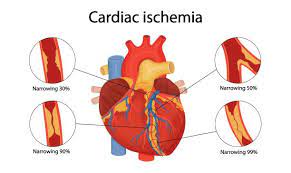ISCHEMIC HEART DISEASE (IHD):
It is an acute or chronic form of a cardiac disability, which arises when there is an
imbalance between the supply and demand of oxygenated blood to Myocardia, is called ischemic heart disease.IHD may also be called as coronary artery disease (CAD). Depending upon the myocardial response and rate and severity of narrowing of coronary artery, one of four diseases may develop includes,
• Angina pectoris (chest pain)
• Chronic ischemic heart disease with CHF(congestive heart failure)
• Acute myocardial infarction
• Sudden cardiac death
The most common cause of ischemic heart disease is a reduction in coronary arterial blood force due to atherosclerosis of the coronary arteries. Factors that contribute to the development of ischaemic heart disease are analogous to those responsible for atherosclerosis in general, and include Hypertension, diabetes mellitus, smoking, high cholesterol, high situations of low viscosity lipoprotein, and inheritable factors and nonatherosclerotic causes are vasospasm, coronary artery stenosis, inflammation of coronary artery, thrombotic disease, trauma, aneurysms and contraction Symptomatic ischemic heart disease is typically associated with a critical stenosis, defined as a 75% or greater reduction in the lumen of one or more coronary arteries by atherosclerotic plaque. With this level of fixed obstruction, the augmented coronary blood follow that may occur as a result of compensatory coronary vasodilation is insufficient to meet even moderate increase in myocardial oxygen demand. In addition to chronic, fixed atherosclerotic plaques, various superimposed lesions also play an important role in the development of myocardial ischemia. These include,
1. Acute changes in the morphology of chronic atherosclerotic plagues include fissuring, haemorrhage into the plaque, and plaque rupture with embolization of atheromataous debris into distal coronary vessels. In addition to causing enlargement of the plaque, local disruption of plaque increases the risk of platelet aggregation and thrombosis at the site.
2. Local plated aggregation in the coronary arteries has been documented in patients with unstable angina pectoris and in patients who undergo sudden cardiac death. Both occlusion of small blood vessels by small platelet vasospasm aggregates and mechanical coronary induced by mediators released from the platelet aggregates may contribute to myocardial ischemia.
3. Coronary artery thrombosis is nearly always associated with a severe
atherosclerotic shrine. Original dislocation of atheromataous pillars plays an
important part in the development of thrombi by exposing thrombogenic, lipid rich
shrine debris to the blood. Thrombi are linked most frequently in cases who have
suffered a myocardial infarct involving the full consistency of the myocardium
although they may also do in cases with other clinical instantiations of cardiac
ischemia, similar as unstable angina pectoris.
4. Coronary artery spasm generally occurs in cases with at least some pre-existing atherosclerosis. It has been associated with one particular type of angina pectoris, nominated Prinzmental’s( variant) angina. At the point of shrine dislocation, it may be convinced by the release of vasospastic intercessors similar to thromboxane A2 by platelet summations. Endothelial dysfunction may also precipitate vasospasm by reduced elaboration of endothelial cell deduced relaxing factors. Increased sympathetic exertion and smoking have also been intertwined.
CLINICAL MANIFESTATIONS OF IHD:
One of the four disease or syndromes may develop depending upon the rate of severity of narrowing of coronary artery and myocardial response
• Chest pain(angina pectoris)
• Myocardial infarction
• Congestive heart failure
• Chronic ischemic heart disease
• May cause sudden cardiac death
PREVENTION OF IHD:
• Maintain proper diet charts and avoid the intake of fat rich food. Fat is the main
factor which increases the levels of lipids in blood so, it is necessary to avoid
saturated fat in order to prevent arteriosclerosis.
• Avoid smoking
• Take proper test
• Lifestyle changes
• Adequate physical exercise is essential
• Level of cholesterol and hypertension should be monitored with proper treatment
TREATMENT OF ISCHEMIC HEART DISEASE:
• Organic Nitrates: This stimulates the intracellular cyclic- GMP, which results in
vascular smooth muscle relaxation of both arterial and venous vasculature.e.g.
Isosorbide dinitrate.
• B- Blockers: B- Blockers act by reducing cardiac work and O2 consumption.e.g. Propranolol, Atenolol.
• Calcium Channel Blockers: Calcium antagonist inhibits the passage of calcium ions through voltage-dependent L- type calcium channels in cell membranes in the heart and vascular smooth muscle as well as some other hyperexcitable apkins.e.g. Amlodipine Nifedipine.
• Statins: IHD is also due to the increased cholesterol situations. Statins are used to reduce the cholesterol situations in hyperactive cholesterolemia. Statins are the
HMG- CoA reductase impediments.e.g. Atorvastatin, Rusvastatin.
• Aspirin: Aspirin improves the rate of survival in cases with acute myocardial
infarction and reduces the threat of myocardial infarction in cases with unstable
angina, and after recovery from myocardial infarction.

